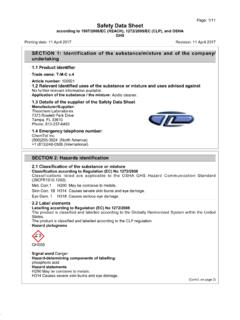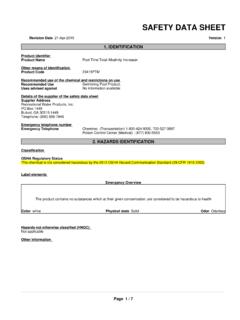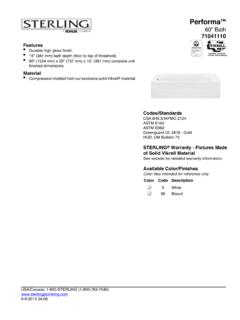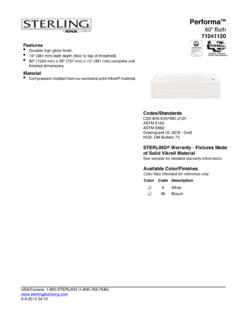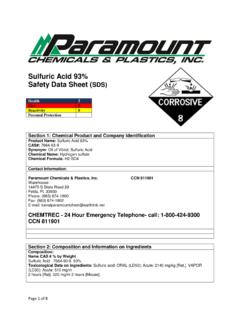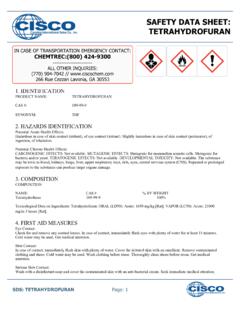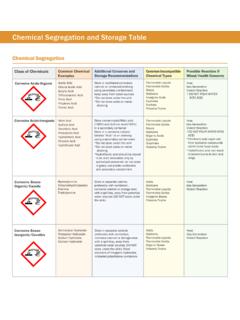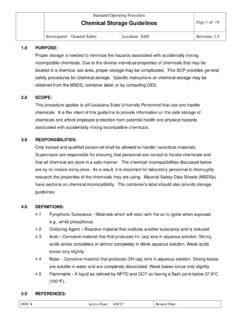Transcription of Safety Data Sheet Bleach-Sodium Hypochlorite 10%
1 Product Name: Bleach-Sodium Hypochlorite 10% PLEASE ENSURE THAT THIS SDS IS GIVEN TO, AND EXPLAINED TO PEOPLE USING THIS PRODUCT. EMERGENCY INFORMATION: INFOTRAC 1-800-535-5053 1 1610 N 170 E Ave. Tulsa Oklahoma 74116 Tel: 918-439-4329 Fax. 918-439-4203 Toll-Free 1-888-834-2001 ; Safety data Sheet Bleach-Sodium Hypochlorite 10% 1. IDENTIFICATION CAS# 7681-52-9 IN AN EMERGENCY CALL: INFOTRAC 1-800-535-5053 2. HAZARD IDENTIFICATION GHS Class Skin corrosion/irritation Category 1 Serious eye damage/eye irritation Category 1 Specific target organ toxicity (single exposure) Category 2 Acute aquatic toxicity Category 1 Chronic aquatic toxicity Category 1 Corrosive to metals Category 1 Oxidizing liquids Category 2 Signal Words DANGER Hazard Statements Causes severe skin burns and eye damage.
2 (H314) May cause damage to organs.(H370) Very toxic to aquatic life with long lasting effects.(H410) GHS Precautionary Statements for Labeling P312 Call a POISON CENTER or doctor if you feel unwell. P301,P330,P331 IF SWALLOWED, rinse mouth. Do NOT induce vomiting. P303,P361,P353 IF ON SKIN (or hair): Remove/take off immediately all contaminated clothing. Rinse skin with water/shower. P363 Wash contaminated clothing before reuse. P304, P340 IF INHALED, Remove victim to fresh air and keep at rest in a position comfortable for breathing. P305,P351,P338 IF IN EYES, Rinse cautiously with water for several minutes. Remove contact lenses, if present and easy to do.
3 Continue rinsing. P310 Immediately call a POISON CENTER doctor/physician. P260 Do not breathe dust/fume/gas/mist/vapors/spray. P264 Wash thoroughly after handling. P270 Do not eat, drink or smoke when using this product. P309, P311 If exposed or if you feel unwell: Call a POISON CENTER or doctor/physician. P405 Store locked up. P273 Avoid release to the environment. P501 Dispose of contents/container to an approved waste disposal plant. P334 Immerse in cool water/wrap in wet bandages. P390 Absorb spillage to prevent material damage. P406 Store in corrosive resistant aluminium container with a resistant inliner. P210 Keep away from heat/sparks/open flames/hot surfaces.
4 No smoking. P220 Keep/store away from clothing/combustible materials. cont d next page Product Name: Bleach-Sodium Hypochlorite 10% PLEASE ENSURE THAT THIS SDS IS GIVEN TO, AND EXPLAINED TO PEOPLE USING THIS PRODUCT. EMERGENCY INFORMATION: INFOTRAC 1-800-535-5053 2 P221 Take any precaution to avoid mixing with combustibles. P280 Wear protective gloves (gauntlet-style) and clothing of neoprene. P370, P378 In case of fire: Use dry sand, dry chemical or alcohol-resistant foam to extinguish. P501 Dispose of contents/container to industrial incineration plant. 3. COMPOSITION CAS NUMBER % sodium Hydroxide 1310-73-2 1 sodium Chloride 7647-14-5 7 sodium Hypochlorite 7681-52-9 12 Water 7732-18-5 balance NOTE: Several other components are either present at or less, or are non-toxic and present at below 1%.
5 4. FIRST AID SKIN: Immediate medical attention is required. Wash off immediately with soap and plenty of water while removing contaminated clothes and shoes. EYES: Immediate medical attention is required. Rinse immediately with plenty of water, also under the eyelids, for at least 15 minutes. Keep eye wide open while rinsing. Do not rub affected area. INHALATION: Move to fresh air. Call a physician or poison control center immediately. If not breathing, give artificial respiration. If breathing is difficult, give oxygen. INGESTION: Immediate medical attention is required. Do NOT induce vomiting. Drink plenty of water. Never give anything by mouth to an unconscious person.
6 Remove from exposure, lie down. Clean mouth with water and drink afterwards plenty of water. Call a physician or poison control center immediately. NOTE: Inadvertent inhalation of vomited material may seriously damage the lungs. The danger of this is greater than the risk of poisoning through absorption of this relatively low-toxicity product. The stomach should only be emptied under medical supervision, after the installation of an airway to protect the lungs. 5. FLAMMABILITY & FIRE-FIGHTING Flash Point cannot burn Autoignition Temperature cannot burn Flammable Limits cannot burn Combustion Products carbon monoxide, nitrogen oxides, sulphur oxides, ammonia, sodium & potassium oxides Firefighting Precautions as for materials sustaining fire; firefighters must wear SCBA Static Discharge cannot accumulate a static charge 6.
7 ACCIDENTAL RELEASE MEASURES Leak Precaution dike to control spillage and prevent environmental contamination Handling Spill recover free liquid with corrosion-resistant pumps; absorb residue on an inert sorbent, sweep, shovel & store in closed containers for disposal 7. HANDLING & STORAGE Store and use away from acids. Never cut, drill, weld or grind on or near this container, whether empty or full. Always replace drum, pail or IBC cap prior to moving the container! Avoid generating or breathing product mist. If mist forms in use, install adequate ventilation to control airborne product concentration to regulated limits (see Part 8, below).
8 Wear suitable protective clothing & equipment. Avoid all contact with skin and wash work clothes frequently. An eye bath and Safety shower should be available near the workplace. 8. EXPOSURE CONTROL & PERSONAL PROTECTION sodium Hydroxide: ACGIH TLV 2mg/m3 ACGIH STEL not listed OSHA PEL 2mg/m3 OSHA STEL not listed Ventilation mechanical ventilation may be required to maintain airborne vapor or mist concentrations below TLV cont d next page Product Name: Bleach-Sodium Hypochlorite 10% PLEASE ENSURE THAT THIS SDS IS GIVEN TO, AND EXPLAINED TO PEOPLE USING THIS PRODUCT. EMERGENCY INFORMATION: INFOTRAC 1-800-535-5053 3 Hands wear gauntlet-style neoprene gloves other types also protect; always confirm suitability with supplier Eyes Safety glasses with side shields and face shield always protect eyes!
9 Clothing impermeable (hands, above) apron, boots, hat and long sleeves, if splashing is anticipated 9. PHYSICAL AND CHEMICAL PROPERTIES Odor & Appearance clear, yellow liquid with a pungent, chlorine odor Odor Threshold N/A Vapor Pressure @ 55 oC Evaporation Rate (Butyl Acetate = 1) N/A Vapor Density (air = 1) N/A Boiling Point 106oC / 222oF Freezing Point -18oC / -1oF Specific Gravity Water Solubility complete Viscosity Centistokes @ 77 oF pH 10. REACTIVITY Conditions to Avoid Exposure to air or moisture over prolonged periods; Excessive heat, exposure to light, reduced alkalinity, and contamination of any kind. Reduced alkalinity or contamination can result in evolution of chlorine (toxic) gas.
10 Decrease in pH such as by mixing with other than water, and contamination with items mentioned below as incompatible can result in evolution of chlorine (toxic) gas. Chemical Stability Stable under normal conditions of use and storage; Stability decreases with increased concentration, heat, light exposure, decrease in pH and contamination with heavy metals such as nickel, cobalt, copper and iron. Incompatible Materials Strong acids and bases; Oxidizing agents; Ether, ammonia compounds, hydrogen peroxide, all acids, alum, reducing agents, human or animal waste, oxidizable or combustible materials such as wood, cloth or organic materials, organic chemicals such as solvents and solvent based cleaning compounds, fuels and fuel oils, amines, methanol, propane, organic polymers, ethylene glycol, insecticides, heavy metals such as iron, copper, magnesium, aluminium, tin, steel, stainless steel, carbon steel, manganese, zinc, chromium, nickel, cobalt and their alloys, sodium sulphite, sodium bisulfite, sodium hydrosulfite, sodium thiosulfate.
